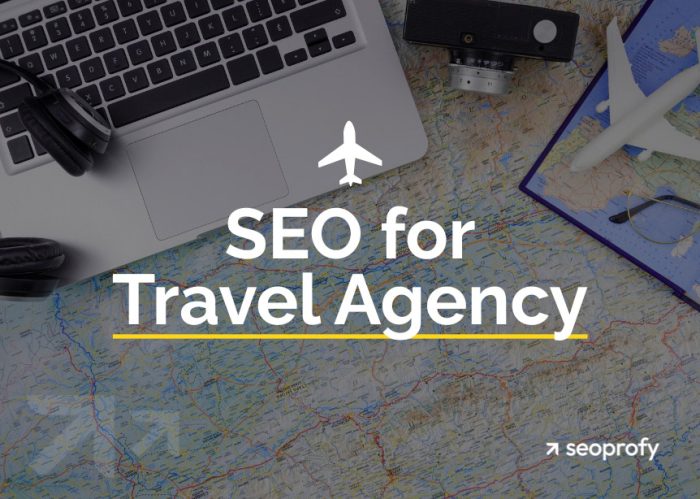SEO for travel agencies is the process of optimizing a website to rank for the searches travelers use when planning trips. It involves researching relevant keywords, building pages for tours and packages, improving site speed and mobile usability, optimizing Google Business Profile for local visibility, and earning backlinks to compete with larger travel platforms and drive bookings.
Any trip planning starts with a Google search and, in recent years, often includes tools like ChatGPT. A traveler might read about tour options through one of the AI tools, and later compare itineraries or prices on different sites. Wherever that search happens, an optimized site is essential to be seen, and in this guide, we’ll show you exactly how to do it with proven SEO tactics we use for our clients every day.
- When working on SEO, travel website owners need to account for seasonality shifts, local competition, and the non-linear buyer journey in this niche.
- For travel agents who serve specific locations, local SEO and optimizing Google Business Profile are important parts of the overall SEO strategy, as they connect the business with travelers searching in that exact area.
- High-quality content and a variety of visuals are a must-have for travel sites, and it’s best to create a mix of formats that match different search intents.
- Most of the travelers look for trips and experiences on their smartphones, so keeping the pages loading fast and mobile-friendly can have a direct impact on how many people book your services.
The Basics of SEO for Travel Sites
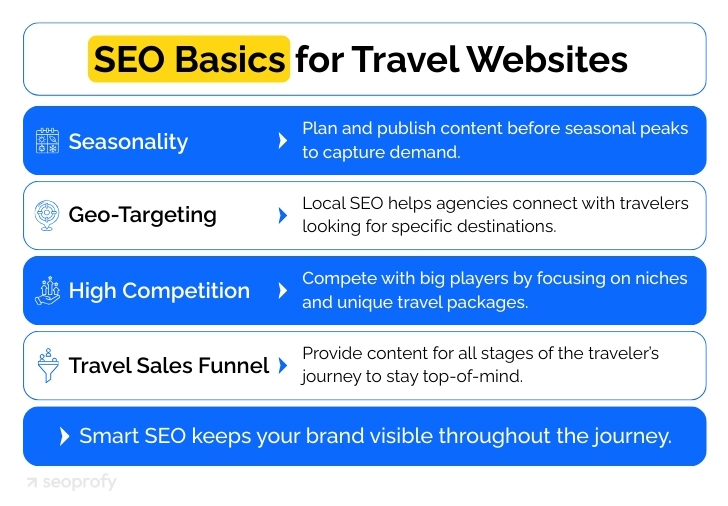
The basics of SEO work in travel the same way as in any other industry. You do the keyword research, create content, and work on the technical side of the site. Still, some factors influence how marketing and SEO strategies are built for this niche.
1. Seasonality
In the travel industry, timing is everything, and interest in destinations shifts with the seasons. This seasonality affects how you plan your SEO strategy, from the topics you cover to the time you publish your pages. The goal is to have your content live before the interest peaks.
2. Geo-Targeting
Many travel agencies offer their services in specific regions or destinations. And for them, local SEO is an important piece of the puzzle because it connects them with travelers searching for experiences in those exact areas.
3. High Competition
Well-known sites like Expedia, TripAdvisor, and Booking.com already rank high for most of the broad travel searches. To have a chance to compete with them, smaller travel agents often get more specialized. They design niche itineraries or custom packages that bigger brands can’t easily replicate.
4. The Travel Sales Funnel
The buying journey in travel rarely happens in a straight line. Someone might start reading about destination ideas, return later to compare itineraries, and only weeks after that decide who to book with. Your site needs to have content for all of these stages, from inspiration and follow-up guides to service pages. This keeps your name in front of them through the entire process, and in travel, that familiarity often tips the scale in your favor.
SEO Advantages for Travel Agencies
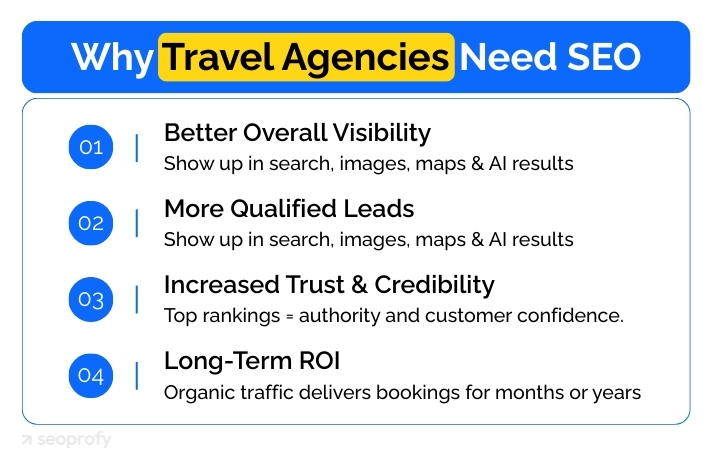
The main reason travel agencies invest in SEO is simple. It puts you in front of travelers at the exact moment they’re searching for what you offer. That could be someone planning a once-in-a-lifetime trip abroad or a local family looking for a weekend getaway. Either way, they find you without you paying for every single click. Moreover, it helps you get:
- Better overall visibility: A well-optimized site of a travel agent can appear in multiple places — regular search results, image searches, AI overviews, and the map pack for local queries. And this omnipresence doubles your chances of getting the click.
- More qualified leads: SEO helps you target specific long-tail queries that potential customers are using when looking for trips or travel services you offer. This means the leads are far more likely to turn into bookings and sales.
- Increased trust and credibility: The more your agency ranks at the top of search engine results, the better sense of authority it creates. People start to view you as credible, even before they’ve clicked through.
- Long-term ROI: In contrast to paid ads, organic rankings can stay in place for months or even years with proper upkeep, meaning the investment you make now continues to draw in new visitors over time.
9 Proven Strategies to Boost Rankings and Sales for Travel Agencies
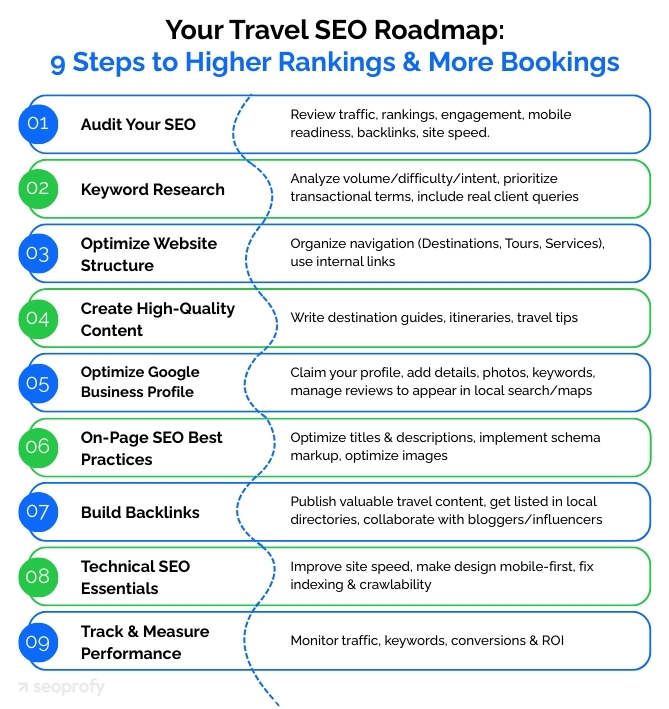
Now that you know the benefits of a well-planned SEO strategy for travel businesses, let’s look at what steps you need to take to optimize your website for better visibility in search engine results pages.
Outline Your Travel SEO Strategy
SEO for travel websites works in much the same way as planning a journey. You’ll first want to see your current SEO performance in search, analyze the competition in the target market, and decide on the goals and metrics you’ll track.
First, review your current website performance. Several tools can be helpful here, such as Google Analytics, Google Search Console, Screaming Frog, and Ahrefs or Semrush. As for the metrics to check, look at the organic search traffic, keyword rankings, engagement metrics, mobile responsiveness, backlinks, and page loading speed.
For example, here are some of the metrics you can see in the Ahrefs overview in Site Explorer:
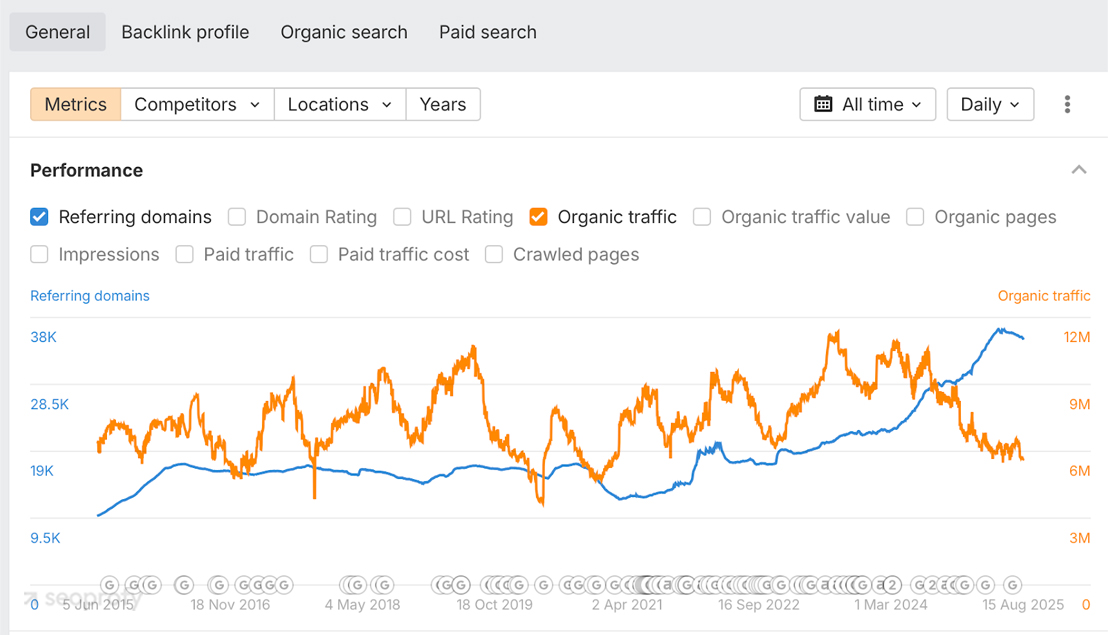
Another helpful feature inside Ahrefs is the Opportunities tab in Site Explorer. Once you paste your site’s URL and head to the left-hand menu, you’ll see a list of quick wins and useful ideas you can act on. For example, it can point out easy keywords — phrases you already rank for but just outside the top spots.
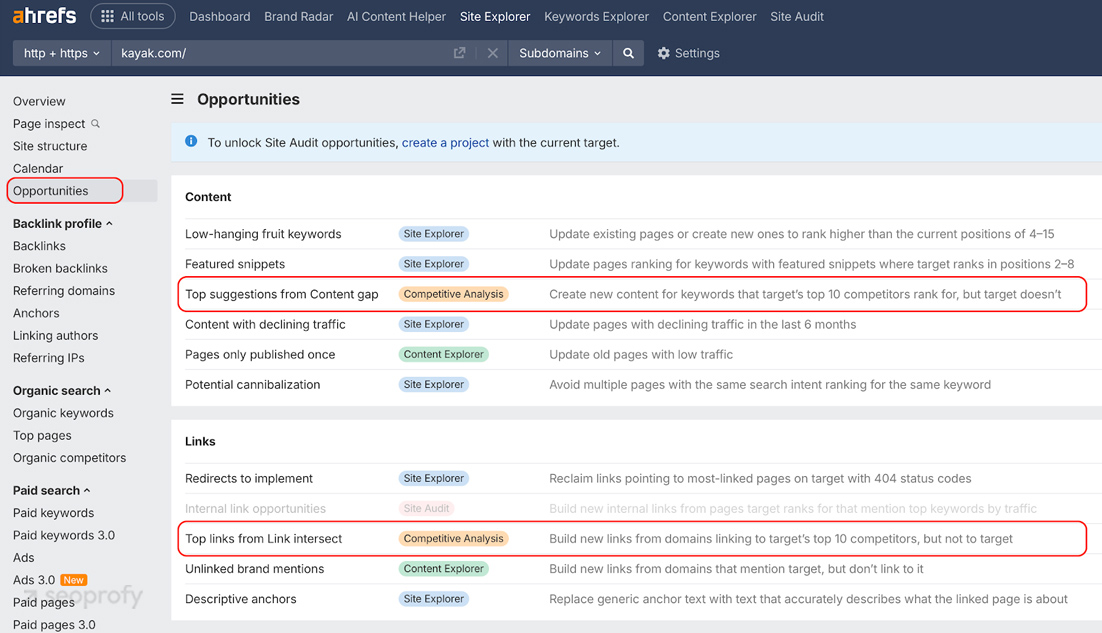
In the same report, you can also find the insights from competitive analysis, such as top suggestions from Content Gap, which lists keywords your top competitors rank for but you don’t. This is a fast way to find relevant content topics worth adding to your strategy.
For a more detailed analysis, you can enter a domain of another travel business targeting the same destinations or experiences as you in the Site Explorer and get even more details on their metrics.
The biggest advantage of this first step is that the data shows you where your strategy falls short and where quick wins are. With that clarity, you can decide what to work on first to bring in more organic visitors and, ultimately, more bookings. At our agency, this analysis is one of the first things we do for clients as part of our SEO services because it sets the direction for the rest of the strategy.
Conduct Targeted Travel Keyword Research
Keyword strategy sits at the heart of every effective travel SEO plan. The terms and phrases you select during this step will become the roadmap for all your content, landing pages, and optimization campaigns.
Collect a Broad List of Keywords
In the beginning, the best approach is to find as many relevant keywords as possible. Since we already talked about Opportunities in Ahrefs earlier, this is a good moment to return to that tab. It can give you a ready-made list of queries you can add to your spreadsheet.
To expand your list, head into Ahrefs Keywords Explorer. Type in your main keywords related to destination areas, types of travel experiences, and seasonal trips you offer, and set the location to match your target market.
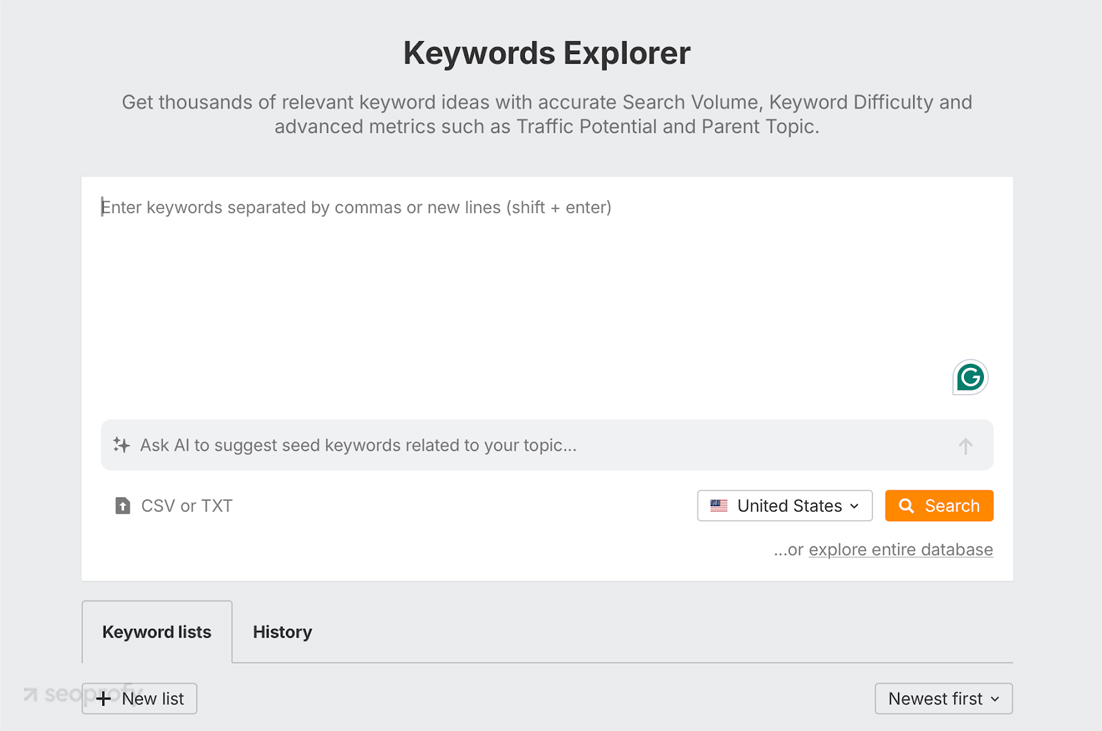
After running the search, you can click on related terms to see thousands of keyword ideas with metrics like search intent, traffic potential, keyword difficulty, and CPC.
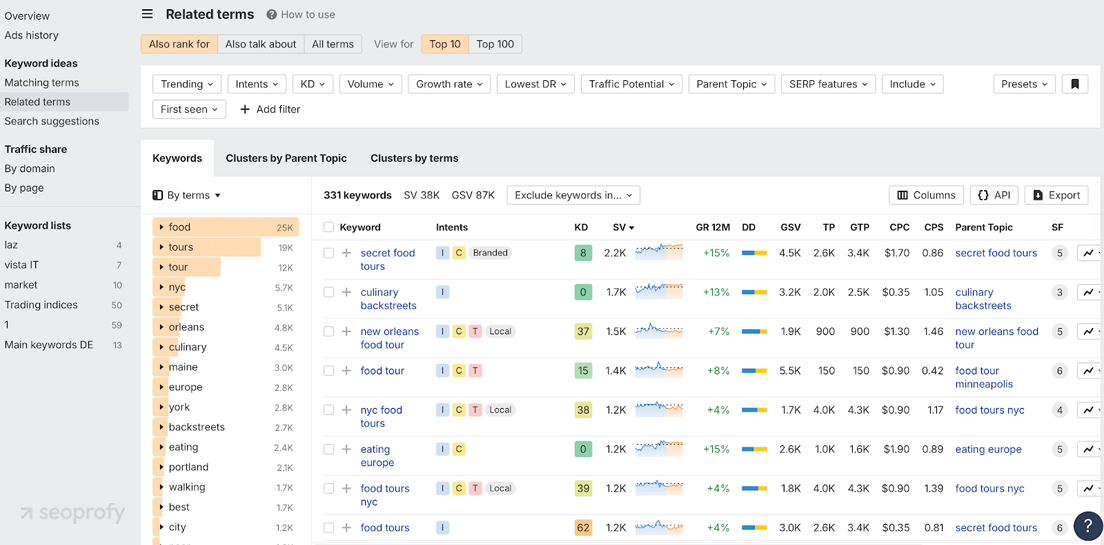
For more local data, you can use KWFinder. It’s a free tool that’s super handy for a local keyword strategy as it lets you drill into location-specific searches and see where demand is higher. In the screenshot below, you can see the dashboard of this tool with keyword data in the state of New York.
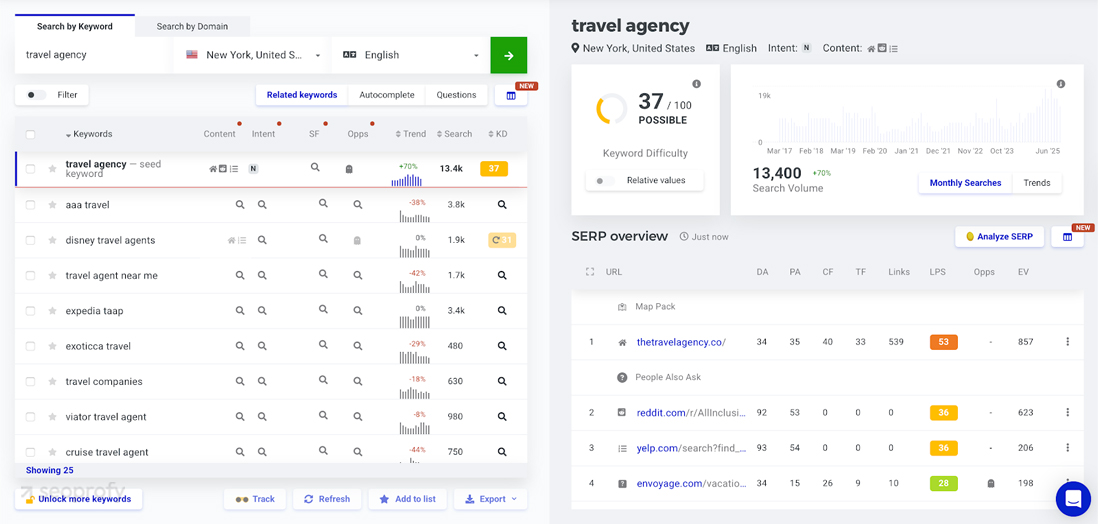
You can then switch to other states to compare interest and trends. While you’re at it, make sure to check the right side of the dashboard, which shows a local SERP view. This gives you a feel for the kind of sites competing for the same keyword.
The final useful tool for travel sites is Google Trends. It shows how interest in a destination or activity changes throughout the year and helps you see when searches start to rise.
Once you have your list, narrow it down using these three metrics: search volume, keyword difficulty, and intent.
- Search volume shows how many people look for a term each month.
- Keyword difficulty tells you how competitive a term is.
- Intent shows the reason someone searches for a term.
For travel agencies, commercial and transactional terms should be the priority since these are the most likely to lead to bookings.
In addition to keyword tools, check your own booking inquiries or common questions from customers in your chat logs. These real-world phrases often reveal high-intent searches.
Optimize Your Website Structure
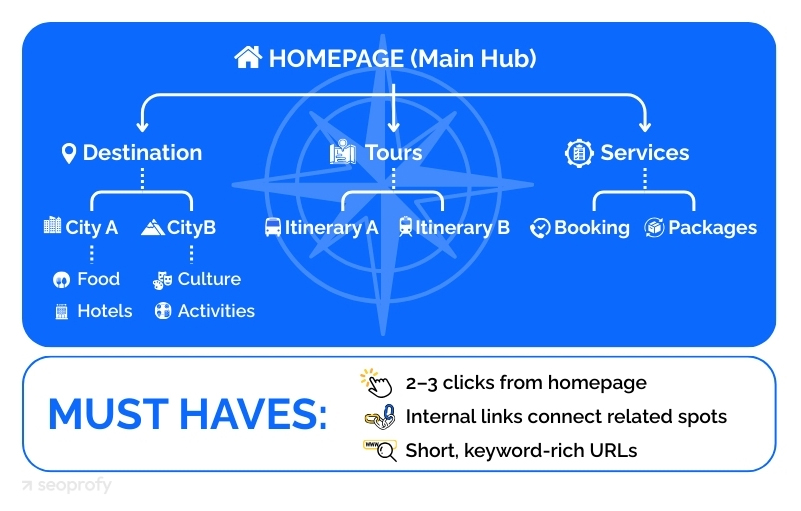
How you arrange your pages influences almost everything in travel industry SEO, from how fast new content gets indexed to how search engines understand your site. It also moves your visitors between related sections and encourages them to stay longer, which is a positive engagement metric. Here are a few areas of site structure you need to optimize for:
- Navigation: Organize your main categories into sections like Destinations, Tours, and Services, and group pages by logical themes.
- Internal links: Connect related pages inside your content to pass authority from high-traffic pages to others and help search engines find and crawl your pages.
- URLs: Keep them short, descriptive, and optimized with keywords.
- Click depth: Place important pages within two or three clicks from the homepage to help them get indexed quickly and remain easy to access for visitors.
Create High-Quality, Travel-Focused Content
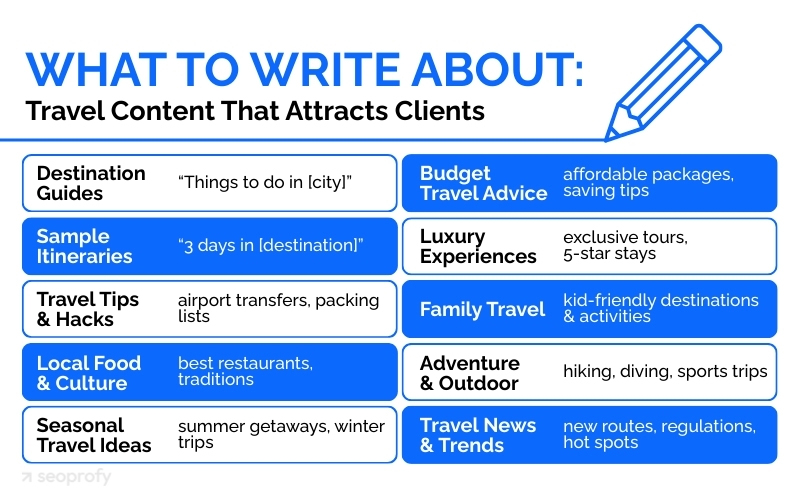
Content for travel businesses is more than a way to describe destinations. It’s a must-have to attract organic traffic and improve search rankings. In your strategy, you’ll want to create a mix of formats that match different search intents:
- Destination guides: These work well for top-of-funnel keywords, where travelers mostly gather ideas and compare locations. For this type of content, target broad queries like “things to do in [city]”.
- Itineraries: Perfect for mid-funnel searches, such as a 3-day in [city] itinerary. These come from travelers who have already chosen the destination and now want a plan. When you’re working on them, lay out each day with headings that match keyword variations, and link to deeper content on attractions, restaurants, or activities you mention. This increases page authority and helps more of your content rank.
- Travel tips: These mostly target long-tail queries, such as “how to get from airport to [city] center” and draw in highly qualified traffic. Such pages build trust and attract visitors who are closer to booking because they’re looking for logistical answers.
Good storytelling is super important for travel blog posts, so make sure to use it in your writing. Let the reader feel the moment so they start picturing themselves in it. This will not only keep your visitors engaged but also reduce bounce rate and send positive signals to search engines.
The final and crucial component of an SEO content strategy is visuals. Let’s be honest, photos, videos, and maps can be as important as the content you write. And since travelers often make decisions with their eyes first, these visuals can tip them from “just looking” to “ready to book.” As a bonus, optimized images can appear in Google’s image packs and get you some extra clicks.
Set Up and Optimize Your Free Google Business Profile
A Business Profile is your free spot on Google Maps and local search results. It’s what people see when they look for travel services in a certain place. It shows them your name, location, contact details, photos, and reviews all in one view. For many travelers, it’s the first thing they click. Here’s what it looks like in Google search results:
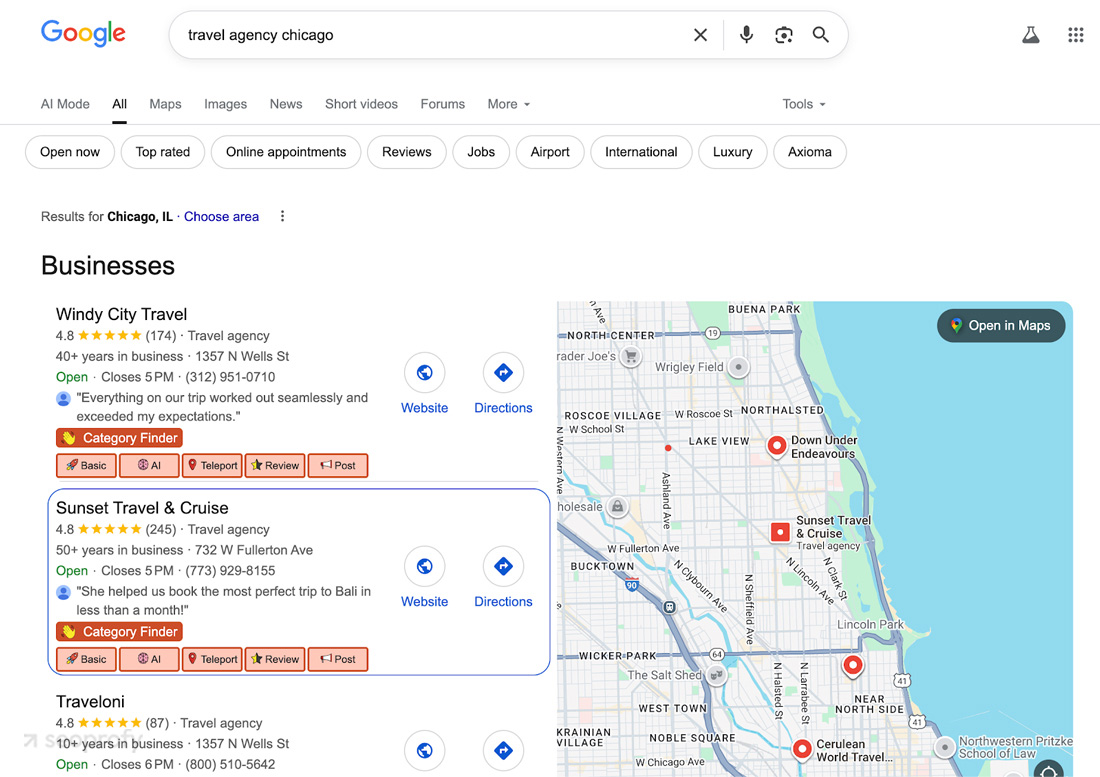
If you haven’t verified yours yet, that’s step one. Go to Google Business Profile Manager, type in your business name, and see if it’s there. Claim it if it is, and if it isn’t, you’ll need to create it. Google will confirm it’s you, most often with a postcard and sometimes by phone or email.
Once you have access, make sure every detail is filled in:
- Name, address, phone, website (keep these the same everywhere online)
- A business category that describes your main service
- The area where you operate and working hours
- Photos of your office and the team
At the same time, keep your profile optimized. Use the main keywords that fit your category and the area you serve. This tells Google what searches you should show up for and helps you rank for local queries.
On-Page SEO Best Practices
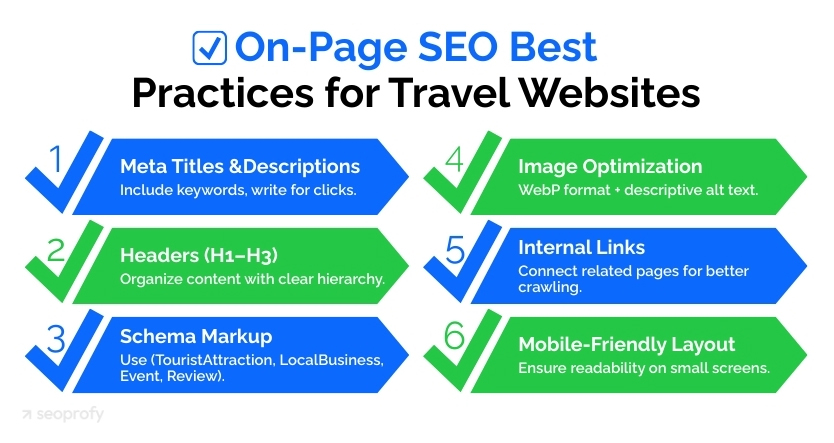
On-page SEO is a part of search engine optimization that deals with everything on your site — content, internal links, images, and other elements that help visitors and search engines understand your pages. We talked about some of its elements in the site structure, so now let’s go over the rest:
Meta Titles And Descriptions
Search engines look at these elements to understand the topic of your page, and potential customers read them in search results to decide which one to click on. You should include your main keyword or its variation in both the meta title and description, and describe what exactly the visitors will find on your page once they land on it.
Headers
The heading structure (H1, H2, H3) gives your page an outline that search engines and visitors can follow. H1 marks the main topic of the page, and H2s and H3s separate the larger themes. This structure benefits your visitors first, but more importantly, it helps search engines and AI systems to interpret the content on your page.
Schema Markup
Schema is a type of code you can add to your pages to give more context to search engines and show up in rich snippets in search results. In the travel niche, the most common ones to use are TouristAttraction, LocalBusiness, Event, and Review schema. They can display ratings for your services or pricing right in the results. Moreover, AI systems often use structured data when generating their answers, so schema can increase your visibility there, too.
Image Optimization
Visuals are one of the most important elements on travel sites that help prospects make a decision. However, a lot of imagery can slow down loading speed if the files are too large and unoptimized. A good practice is to save images in formats like WebP for faster loading and add a descriptive alt text, so search engines have more context and can show them in an image pack for relevant searches.
Link Building for Travel Websites
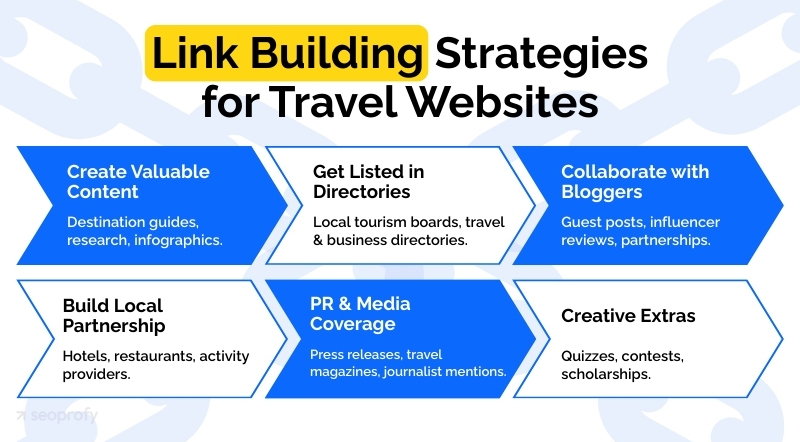
Backlinks are still one of the biggest ranking signals Google uses to measure a website’s authority, and 92% of marketers believe this will continue to be true in the coming years. In the eyes of search engines, they act as a recommendation, and the more of these recommendations you earn from credible and relevant sources, the more trust your site builds in search.
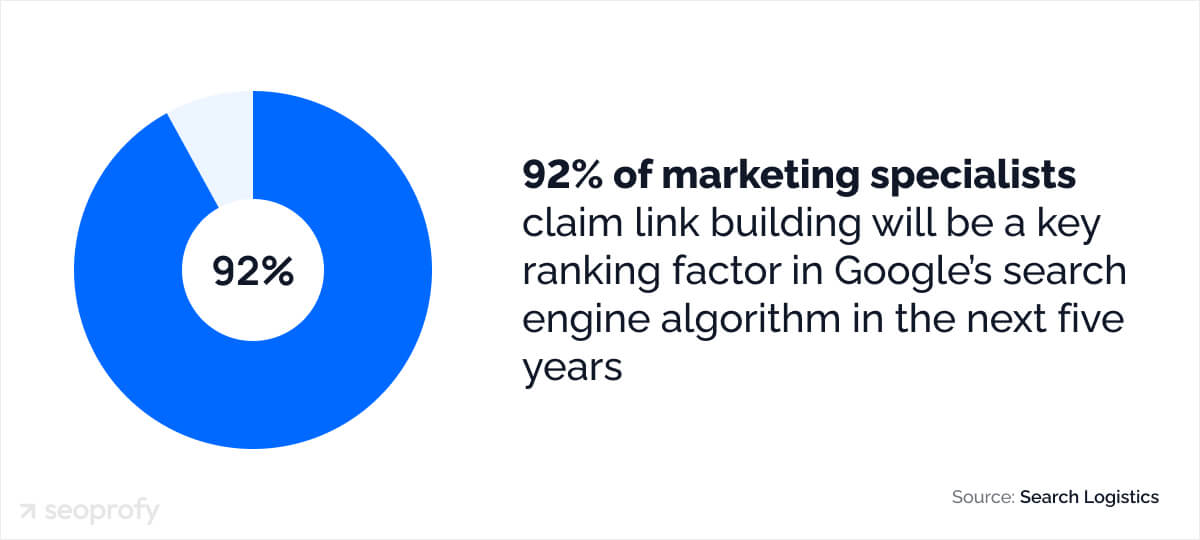
In SEO for travel industry, you have plenty of opportunities to earn mentions in ways that make sense for your business. Here are a few link building strategies you can try:
- Create valuable travel content: This is one of the best ways to earn quality backlinks organically. Travel blogs and news websites are often on the lookout for sources to use in their articles. You could publish detailed destination guides, original data, or expert travel tips to attract them.
- Get listed in travel and local directories: Many cities have official sites that list local operators. Being listed there is a quick win, and those links are especially relevant because they come from trusted and local sources.
- Collaborate with travel bloggers and influencers: There are all kinds of travel bloggers and influencers who share their travel experiences online. You could offer them a tour in exchange for honest reviews or guest posts that include links back to your site.
- Visual assets: Travel is visual by nature, and that gives you an advantage when creating linkable assets. Creative infographics and interactive maps are likely to be shared by bloggers and even picked up by online publications.
At the same time, remember to build links from a variety of sources. It creates a much stronger backlink profile than using only one method.
Technical SEO Essentials
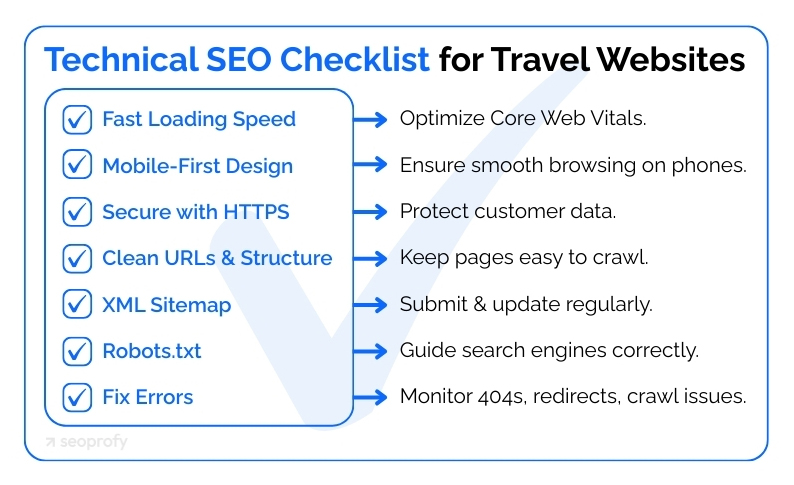
The final and essential step for every travel SEO strategy is technical optimization. It directly influences your user experience (UX), search engine rankings, and overall visibility. That said, this part of SEO gets outsourced the most, so if you feel like you don’t have experts to do it in-house, you can always partner with a professional SEO company or a freelancer. One way or another, here are some of the areas to keep in check:
Improve Site Speed and Core Web Vitals
Speed is one of the first things to look at. Travelers won’t wait around for a page that takes forever to load, and it’s actually one of the top reasons why visitors leave a site. Google pays close attention to it as well, through Core Web Vitals.
These metrics measure how quickly your main content shows up, how stable the page feels as it loads, and how fast it responds to clicks. You can check all of this in PageSpeed Insights or inside Search Console. A good place to start is with your top-performing pages, since even a small improvement there has a direct impact on bookings.
Make Your Design Mobile-First
Many travelers plan their trips on smartphones, and Google uses mobile-first indexing. One of the ways to understand how your site works on smaller screens is to check PageSpeedInsights. It shows how real visitors navigate it and pinpoints issues that might affect the user experience on your site.
Keep Your Website Secure
When people are ready to book, they expect to feel safe entering their personal details. If a site flashes a “not secure” warning, they leave instantly. Running your website on HTTPS solves this and shows visitors that their data is protected. Google also gives preference to secure sites, so it benefits both trust and rankings.
Monitor Indexing and Crawlability
For your SEO and content efforts to work and attract traffic, search bots first need to find and index your pages. A couple of ways to help are submitting an XML sitemap and setting up a robots.txt file correctly. In addition, check the Pages report in Search Console regularly to see if all your important pages get shown in search results.
Track and Measure SEO Performance
SEO for a travel company only proves its value once you monitor and measure the outcome of your campaigns. The free tool every travel agency owner can use is Google Analytics 4. It shows you several important metrics: the number of new users, the paths people take through your site, and the number of key events such as conversions. The screenshot below gives you an idea of what these reports look like in practice.
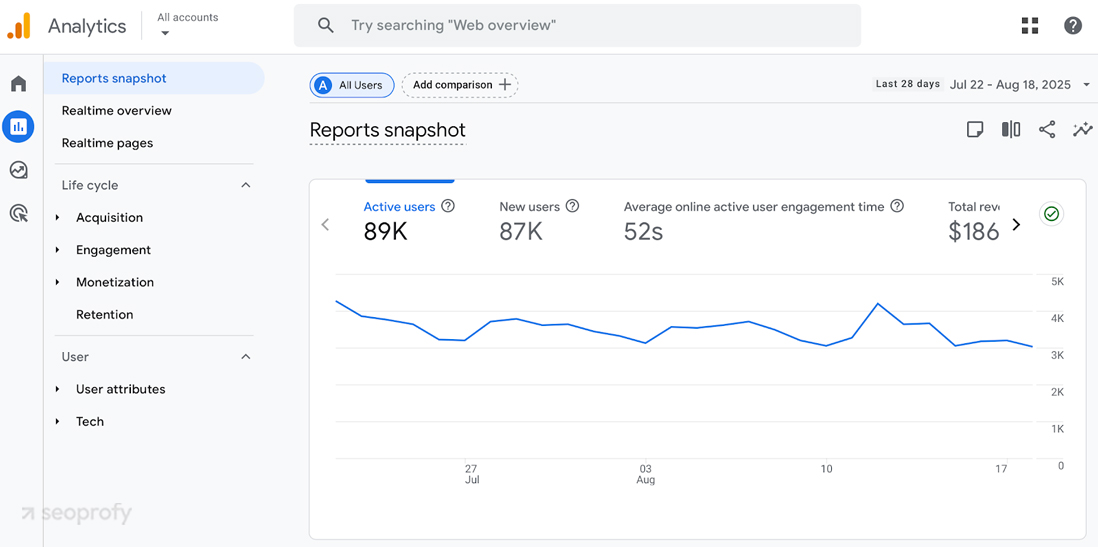
Another tool you can use, which we mentioned earlier, is Search Console. Here, you can track impressions, clicks, and the exact queries that bring in organic traffic. It also points out indexing issues, which means you’ll quickly see if an important page isn’t showing up in Google.
For more advanced data on your SEO performance, it’s better to use specialized tools, such as those from Ahrefs or Semrush. They let you follow specific terms over time to see how your content is moving up or down in results. Here’s an example of an organic keywords overview in Ahrefs, where you can even filter queries by intent or by whether they’re local or non-local.
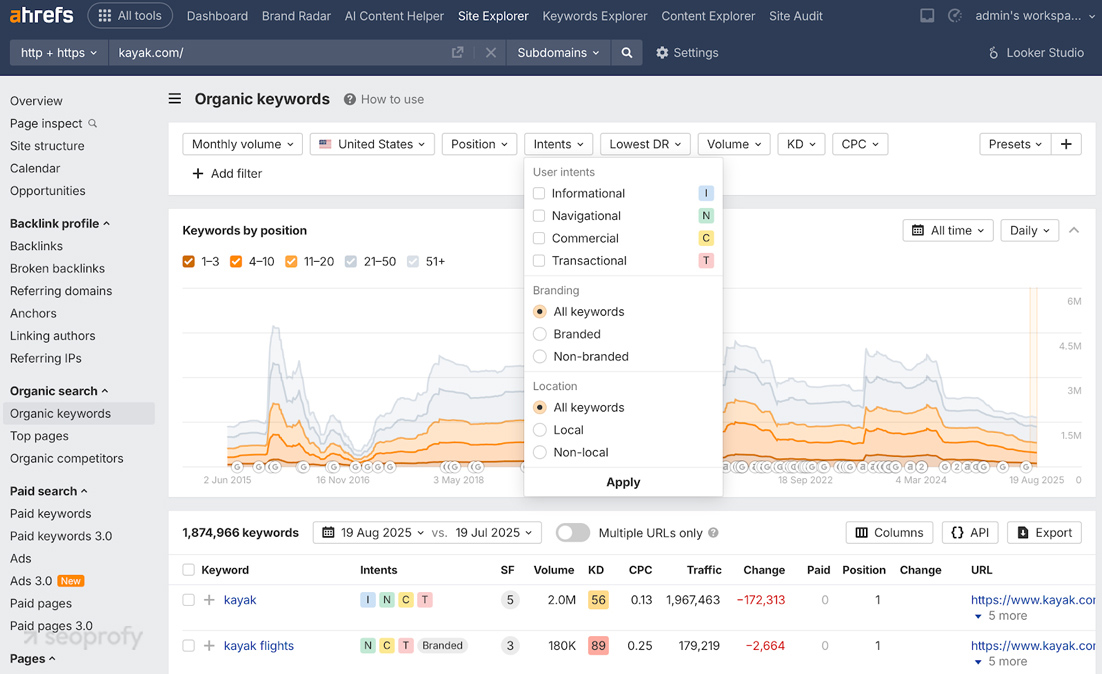
Of course, you can check many other metrics with these tools, such as backlinks, top pages, and competitors’ activity, so you can understand where your site stands and what to adjust.
As for the KPIs to track, these will mostly depend on your SEO goals. Still, we recommend keeping an eye on organic sessions and the number of keywords ranking in the top 10. More importantly, monitor the conversion rate and cost per acquisition from organic traffic, as these give you a sense of how much impact your SEO work is having on the business.
SEO gives you a way to build steady visibility and attract bookings directly from search. Partner with our agency today to:
- Get a consistent flow of leads
- Stop depending on ads
- Build authority in your niche

Travel SEO Challenges You Need to Know
Anyone working in the travel industry knows that it comes with several challenges that influence SEO and marketing strategies. Here are some of the most common ones:
- High competition: The travel market is filled with agencies all competing for the same attention. Moreover, you’ll find that big names and global tour operators rank at the top of search results for most of the broad destination terms. It doesn’t mean that smaller businesses can’t compete; it’s just that they need a more personalized approach to SEO.
- Seasonal traffic drops: Travel interest changes from season to season, and this can create natural traffic swings. One way to work around this is to plan content and campaigns around these cycles, so you’re prepared for the highs and can still engage visitors in the quieter months.
- Algorithm updates: Every so often, Google changes its algorithm, primarily to improve user experience. These changes can sometimes lead to drops in traffic and rankings. To manage this, it’s important to maintain a well-optimized site and always check the Search Console for any issues.
Take Your Travel SEO to the Next Level
SEO for travel agents has many benefits, and the tactics we shared in this guide will give you a good foundation to build on. They’ll help you create visibility that lasts through seasons and shifts in demand. And in travel, steady visibility means more opportunities to grow.
At SeoProfy, we’ve been providing SEO services for travel agencies for more than a decade. Our team has worked with local operators, global brands, and everything in between. When you want your SEO to move beyond experiments and turn into a consistent growth channel, we can support you with:
- Strategies built around your market and goals
- In-house tools that show growth opportunities competitors miss
- A team with 13+ years of hands-on SEO experience
If you’re ready to take the next step, schedule a free, no-strings-attached consultation.


